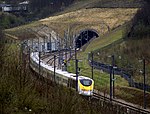Blue Bell Hill

Blue Bell Hill is a chalk hill between Maidstone and Rochester in the English county of Kent. It overlooks the River Medway and is part of the North Downs. Settlements on the hill include the Walderslade suburb of Chatham and the villages of Blue Bell Hill and Kit's Coty. During the eighteenth and nineteenth centuries much of the hill was quarried for chalk.The hill is a 5-hectare (12-acre) nature reserve which is managed by Kent Wildlife Trust. It is also part of the Kent Downs Area of Outstanding Natural Beauty and Wouldham to Detling Escarpment Sites of Special Scientific Interest and is a Nature Conservation Review site, Grade I.A picnic area serves as a rest point for walkers on the North Downs Way which runs along the top of the hill, whilst the prehistoric trackway of the Pilgrims' Way skirts its foot. A modern crematorium also surmounts the hill. The A229 dual carriageway follows the route of a former Roman road and climbs the hill, today linking the M2 and M20 motorways. High Speed 1 runs beneath the hill, via the North Downs Tunnel, and archaeological work in advance of it uncovered a Neolithic long house on its slopes. The Bluebell Hill transmitting station is on the hill, as is the Lower Bell pub. The Upper Bell pub was closed around March 2005 due to the reduced demand caused by the closure of a slip-lane onto the southbound A229, and then demolished in 2013.
Excerpt from the Wikipedia article Blue Bell Hill (License: CC BY-SA 3.0, Authors, Images).Blue Bell Hill
Tonbridge and Malling Aylesford
Geographical coordinates (GPS) Address Nearby Places Show on map
Geographical coordinates (GPS)
| Latitude | Longitude |
|---|---|
| N 51.333333333333 ° | E 0.5 ° |
Address
ME5 9RG Tonbridge and Malling, Aylesford
England, United Kingdom
Open on Google Maps











